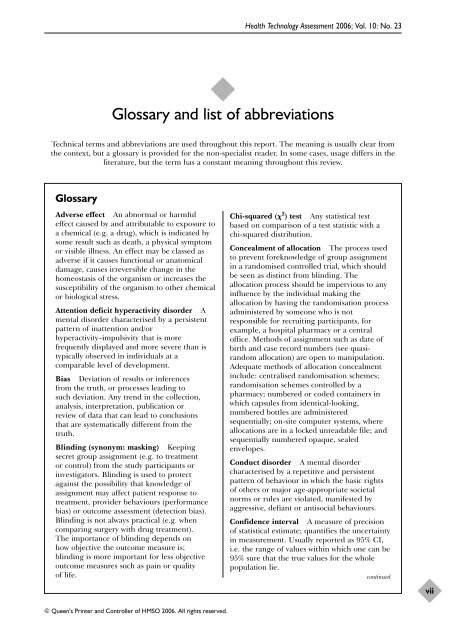A systematic review and economic model of the effectiveness and ...
A systematic review and economic model of the effectiveness and ...
A systematic review and economic model of the effectiveness and ...
You also want an ePaper? Increase the reach of your titles
YUMPU automatically turns print PDFs into web optimized ePapers that Google loves.
Glossary<br />
Adverse effect An abnormal or harmful<br />
effect caused by <strong>and</strong> attributable to exposure to<br />
a chemical (e.g. a drug), which is indicated by<br />
some result such as death, a physical symptom<br />
or visible illness. An effect may be classed as<br />
adverse if it causes functional or anatomical<br />
damage, causes irreversible change in <strong>the</strong><br />
homeostasis <strong>of</strong> <strong>the</strong> organism or increases <strong>the</strong><br />
susceptibility <strong>of</strong> <strong>the</strong> organism to o<strong>the</strong>r chemical<br />
or biological stress.<br />
Attention deficit hyperactivity disorder A<br />
mental disorder characterised by a persistent<br />
pattern <strong>of</strong> inattention <strong>and</strong>/or<br />
hyperactivity–impulsivity that is more<br />
frequently displayed <strong>and</strong> more severe than is<br />
typically observed in individuals at a<br />
comparable level <strong>of</strong> development.<br />
Bias Deviation <strong>of</strong> results or inferences<br />
from <strong>the</strong> truth, or processes leading to<br />
such deviation. Any trend in <strong>the</strong> collection,<br />
analysis, interpretation, publication or<br />
<strong>review</strong> <strong>of</strong> data that can lead to conclusions<br />
that are <strong>systematic</strong>ally different from <strong>the</strong><br />
truth.<br />
Blinding (synonym: masking) Keeping<br />
secret group assignment (e.g. to treatment<br />
or control) from <strong>the</strong> study participants or<br />
investigators. Blinding is used to protect<br />
against <strong>the</strong> possibility that knowledge <strong>of</strong><br />
assignment may affect patient response to<br />
treatment, provider behaviours (performance<br />
bias) or outcome assessment (detection bias).<br />
Blinding is not always practical (e.g. when<br />
comparing surgery with drug treatment).<br />
The importance <strong>of</strong> blinding depends on<br />
how objective <strong>the</strong> outcome measure is;<br />
blinding is more important for less objective<br />
outcome measures such as pain or quality<br />
<strong>of</strong> life.<br />
Health Technology Assessment 2006; Vol. 10: No. 23<br />
Glossary <strong>and</strong> list <strong>of</strong> abbreviations<br />
Technical terms <strong>and</strong> abbreviations are used throughout this report. The meaning is usually clear from<br />
<strong>the</strong> context, but a glossary is provided for <strong>the</strong> non-specialist reader. In some cases, usage differs in <strong>the</strong><br />
literature, but <strong>the</strong> term has a constant meaning throughout this <strong>review</strong>.<br />
© Queen’s Printer <strong>and</strong> Controller <strong>of</strong> HMSO 2006. All rights reserved.<br />
Chi-squared (2 ) test Any statistical test<br />
based on comparison <strong>of</strong> a test statistic with a<br />
chi-squared distribution.<br />
Concealment <strong>of</strong> allocation The process used<br />
to prevent foreknowledge <strong>of</strong> group assignment<br />
in a r<strong>and</strong>omised controlled trial, which should<br />
be seen as distinct from blinding. The<br />
allocation process should be impervious to any<br />
influence by <strong>the</strong> individual making <strong>the</strong><br />
allocation by having <strong>the</strong> r<strong>and</strong>omisation process<br />
administered by someone who is not<br />
responsible for recruiting participants, for<br />
example, a hospital pharmacy or a central<br />
<strong>of</strong>fice. Methods <strong>of</strong> assignment such as date <strong>of</strong><br />
birth <strong>and</strong> case record numbers (see quasir<strong>and</strong>om<br />
allocation) are open to manipulation.<br />
Adequate methods <strong>of</strong> allocation concealment<br />
include: centralised r<strong>and</strong>omisation schemes;<br />
r<strong>and</strong>omisation schemes controlled by a<br />
pharmacy; numbered or coded containers in<br />
which capsules from identical-looking,<br />
numbered bottles are administered<br />
sequentially; on-site computer systems, where<br />
allocations are in a locked unreadable file; <strong>and</strong><br />
sequentially numbered opaque, sealed<br />
envelopes.<br />
Conduct disorder A mental disorder<br />
characterised by a repetitive <strong>and</strong> persistent<br />
pattern <strong>of</strong> behaviour in which <strong>the</strong> basic rights<br />
<strong>of</strong> o<strong>the</strong>rs or major age-appropriate societal<br />
norms or rules are violated, manifested by<br />
aggressive, defiant or antisocial behaviours.<br />
Confidence interval A measure <strong>of</strong> precision<br />
<strong>of</strong> statistical estimate; quantifies <strong>the</strong> uncertainty<br />
in measurement. Usually reported as 95% CI,<br />
i.e. <strong>the</strong> range <strong>of</strong> values within which one can be<br />
95% sure that <strong>the</strong> true values for <strong>the</strong> whole<br />
population lie.<br />
continued<br />
vii
















